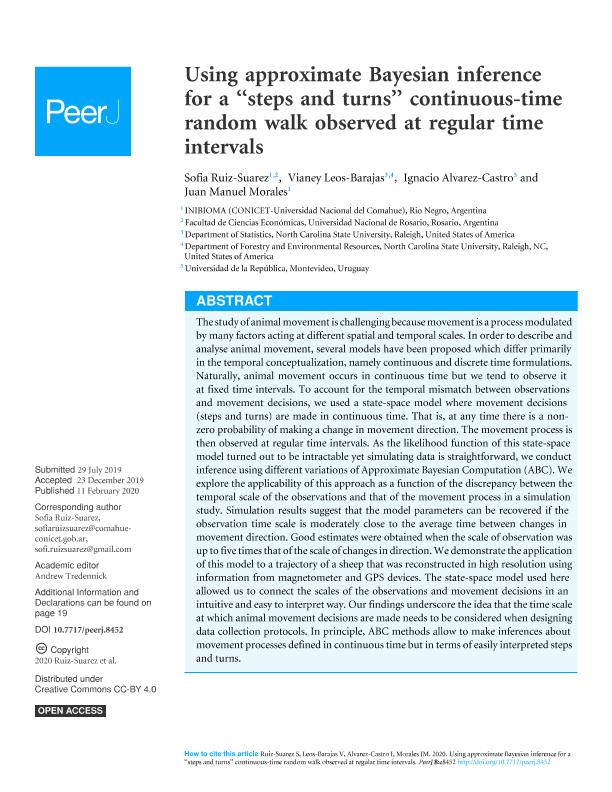Artículo
Using approximate Bayesian inference for a “steps and turns” continuous-time random walk observed at regular time intervals
Fecha de publicación:
02/2020
Editorial:
PeerJ
Revista:
PeerJ
e-ISSN:
2167-8359
Idioma:
Inglés
Tipo de recurso:
Artículo publicado
Clasificación temática:
Resumen
The study of animal movement is challenging because movement is a process modulated by many factors acting at different spatial and temporal scales. In order to describe and analyse animal movement, several models have been proposed which differ primarily in the temporal conceptualization, namely continuous and discrete time formulations. Naturally, animal movement occurs in continuous time but we tend to observe it at fixed time intervals. To account for the temporal mismatch between observations and movement decisions, we used a state-space model where movement decisions (steps and turns) are made in continuous time. That is, at any time there is a non-zero probability of making a change in movement direction. The movement process is then observed at regular time intervals. As the likelihood function of this state-space model turned out to be intractable yet simulating data is straightforward, we conduct inference using different variations of Approximate Bayesian Computation (ABC). We explore the applicability of this approach as a function of the discrepancy between the temporal scale of the observations and that of the movement process in a simulation study. Simulation results suggest that the model parameters can be recovered if the observation time scale is moderately close to the average time between changes in movement direction. Good estimates were obtained when the scale of observation was up to five times that of the scale of changes in direction. We demonstrate the application of this model to a trajectory of a sheep that was reconstructed in high resolution using information from magnetometer and GPS devices. The state-space model used here allowed us to connect the scales of the observations and movement decisions in an intuitive and easy to interpret way. Our findings underscore the idea that the time scale at which animal movement decisions are made needs to be considered when designing data collection protocols. In principle, ABC methods allow to make inferences about movement processes defined in continuous time but in terms of easily interpreted steps and turns.
Palabras clave:
ANIMAL BEHAVIOUR
,
COMPUTATIONAL BIOLOGY
,
MOVEMENT ECOLOGY
Archivos asociados
Licencia
Identificadores
Colecciones
Articulos(INIBIOMA)
Articulos de INST. DE INVEST.EN BIODIVERSIDAD Y MEDIOAMBIENTE
Articulos de INST. DE INVEST.EN BIODIVERSIDAD Y MEDIOAMBIENTE
Citación
Ruiz Suarez, Sofia Helena; Leos Barajas, Vianey; Alvarez Castro, Ignacio; Morales, Juan Manuel; Using approximate Bayesian inference for a “steps and turns” continuous-time random walk observed at regular time intervals; PeerJ; PeerJ; 8; 2-2020; 1-23
Compartir
Altmétricas




